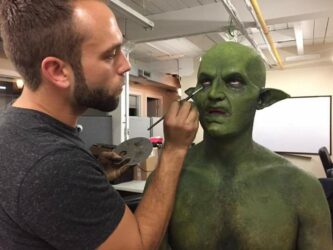Shaun Hunter, a 34-year-old special effects make-up and prosthetics artist for film and television, has a passion for things that are scary, disturbing, and out of this world. He transforms people into monsters, aliens, old people, and more.

Shaun Hunter, right, and another make-up artist working on a model for a music video for Born Ruffian's song Miss You in 2018. Photo credit: Shaun Hunter
Hunter was always an artist at heart, even when he was a kid. He focused on computer animations until he watched a behind-the-scenes documentary about Zack Synder’s 2004 a remake of the horror classic Dawn of the Dead. Something clicked in him and thought, “people do this for a living?”
He saw how special effects were used in one scene where a woman’s arm was cut off by a chainsaw. It showed the process from beginning to end, and that is where Hunter started his journey, by researching makeup schools.
Hunter studied at Toronto’s SOMA, the School of Makeup Art, which has now shut its doors permanently.
“It was clear to me that whatever I did with the rest of my life after high school needed to be in the arts because I wouldn’t be happy with my life if I didn’t do something creative and worked with my hands,” Hunter said.
Hunter loves to make monsters and ugly things. He takes some inspiration from the monsters in The Lord of the Ring by J.R.R. Tolkien and were brought to life by film director Peter Jackson.

Shaun working on a monster as a "proof of concept" for a potential client that did not make it to production. Photo credit: Shaun Hunter
Some of the productions that Hunter was part of are Ready or Not, Trickster, the remake of The Craft, Season 2 of Frontier, and the remake of Resident Evil.
Hunter said the hardest part of the job is balance.
“You have to balance being skilled at the task your doing, having a professional way about you to be able to talk and present yourself as a professional, and work under high stakes and short timelines,” Hunter said.
He said having one of these things is hard enough to cope with but having all four means someone might fall short in some aspects. In the end, it’s going to be difficult but they need all four to do well in the industry, Hunter said.
He said the most interesting part about his job was that it is always different,
“I am so interested in all the different very creative and fulfilling things that film causes you to make,” Hunter said.
Hunter’s works can take months to prepare and hours to execute. There is a process in what Hunter has to go through to transform someone and, for example, make them older.
The talking phase, which is where the crew that he is working with decides the age of the person under the mask will be and how old do they need them to look, and whether the character looks good or bad for that age.
The crew needs to decide how far can they go in effects, meaning does the crew need to add facial hair or a bald cap or a wig, based on the time and money the production wants to give for the process.
A life cast is taken to get an impression of a model’s face, and that means every pore, wrinkle, and imperfection are taken into account to ensure every piece fits exactly to the individual’s face.
The next step is sculpting, where Hunter decides how these pieces will look and starts designing the final product. After that Hunter will start to cast, using foam latex or silicone appliances to make the prosthetic that will be on the actor’s face.
The final step involves applying the cast to the model’s face with all the make-up, wigs, and everything they need to transform an actor.

Shaun Hunter, middle, working on a model for the 2019 movie The Sanctuary, a drama thriller by Akool Film Co. Photo credit: Shaun Hunter
“You are only gonna be as successful as you wanna be with practice and experience and every job that you do,” Hunter said. “You need to be grateful for all the things you did right but you need to be constructive of the things you can do better next time.”
